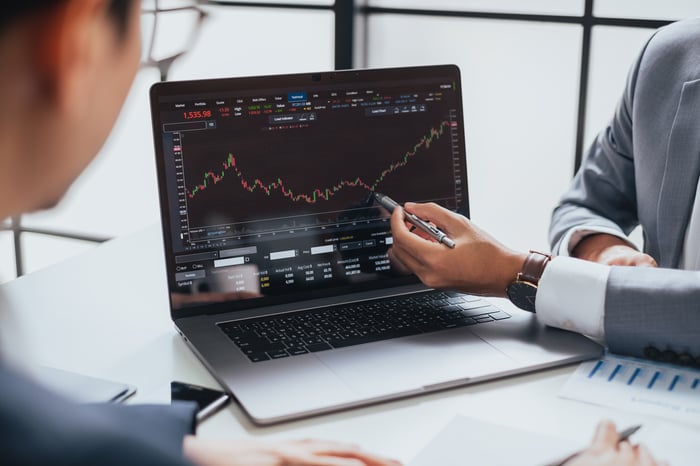It's no secret that this year hasn't gone as many had expected. Following one of the least volatile years in recent memory (2021), all three major U.S. stock indexes have plummeted into a bear market in 2022 with peak declines of at least 20%. The growth stock-focused Nasdaq Composite (^IXIC 1.11%) has fared the worst, with a peak-to-trough decline of 38%, relative to its November 2021 all-time high.
Bear markets are known for testing investors' emotions and their resolve to stick around. But they're also, historically, short-term events. More importantly, the losses associated with every bear market for the major indexes (including the Nasdaq Composite) have eventually been wiped away by a bull market rally. This makes every sizable dip in the broader market a buying opportunity for patient investors.

Image source: Getty Images.
It's an especially smart time to consider putting your money to work in growth stocks, which as noted have been hit hard by the 2022 bear market. What follows are three surefire growth stocks investors can buy during the Nasdaq bear market to end the year right.
The first rock-solid growth stock to buy to end the year on a high note is social media up-and-comer Pinterest (PINS 1.02%).
Since peaking early last year, shares of Pinterest have taken a beating -- down more than 70%. The primary issue skeptics have with Pinterest is that it's an ad-driven operating model. Advertising is often one of the first spending categories to be cut when economic growth tapers off. As a reminder, the first two quarters of 2022 featured a retracement in U.S. gross domestic product (GDP).
The other potential concern for Pinterest is that app developers are now allowing consumers to opt out of data-tracking software. Not having this data can compromise the ad-pricing power of social media networks.
Yet in spite of these headwinds, Pinterest stands out as a no-brainer buy for two very key reasons.
To begin with, Pinterest has shown no slowdown in its ability to monetize its monthly active users (MAUs). Although its MAUs have fluctuated due to the onset of the COVID-19 pandemic and now the rollout of vaccines, global average revenue per user (ARPU) has consistently climbed by a double-digit percentage. ARPU has been particularly strong in overseas markets, with the exception of Europe in the most recent quarter. What this shows is that advertisers see value in Pinterest's 445 million MAUs and are willing to pay a premium to get their message in front of these prospective shoppers.
The other standout reason to buy Pinterest is that data-tracking software changes aren't a big deal for the company. Whereas other sites rely on likes and other tracking tools to help advertisers target users, Pinterest's entire platform is designed to coerce its users to freely share what products and services interest them. There's no guesswork involved for advertisers.
The cherry on top for Pinterest is that it ended September with nearly $2.7 billion in cash, cash equivalents, and marketable securities. This gives the company more than enough capital to innovate and explore a possible long-term transition to becoming an e-commerce player.
Exelixis
A second surefire growth stock to buy during the Nasdaq bear market that can help you end the year right is biotech stock Exelixis (EXEL 1.55%). Although shares are down by only 7% in 2022, that's a surprisingly poor performance given the multitude of catalysts that lie ahead and the amazing value being presented to investors.
The first thing to understand about drug developers is that they're often immune to recessions and bear markets. Since people don't get to control when they get sick or what ailment(s) they develop, there's always demand for prescription therapies. In Exelixis' case, its cancer drug patients will still need its therapies, even if the U.S. enters a recession or the Nasdaq remains in a bear market.
For the moment, lead drug Cabometyx is the company's bread-and-butter cash-flow driver. Cabometyx is approved to treat first- and second-line renal cell carcinoma (RCC), as well as previously treated advanced hepatocellular carcinoma. These indications have pushed Cabometyx's sales to more than $1 billion annually -- but this could be just the beginning.
Exelixis has been testing its top drug in approximately six dozen clinical studies, with the end goal to expand its label. While not all of these trials will prove successful, a combination treatment with cancer immunotherapies developed by Bristol Myers Squibb has already translated into an approval in first-line RCC.
But the real eyebrow-raiser might be Exelixis' newfound commitment to diversify its product portfolio and pipeline by investing aggressively in internal innovation and collaborations. Just in November, the company announced three agreements to collaborate on cancer-drug development.
In terms of valuation, investors are getting a company capable of sustained double-digit sales growth for less than 17 times Wall Street's forecast earnings for 2023. When coupled with a balance sheet that has $2.1 billion in cash, cash equivalents, and restricted cash equivalents and investments, Exelixis stands out as a clear-cut buy.

Image source: Getty Images.
Fiverr International
The third surefire growth stock to buy to end the year right is online-services marketplace Fiverr International (FVRR -1.17%).
Similar to Pinterest, the COVID-19 pandemic took shares of Fiverr on a wild ride. In a span of 2.5 years, Fiverr went from the mid-$20s to north of $300, then came all the way back to the mid-$20s. It would appear that the biggest concern impacting Fiverr these days is the growing likelihood of a U.S. recession. With interest rates rising at their fastest pace in decades, hiring, and the need for freelance labor, could slow dramatically in the months to come.
While there's the very real possibility that a recession would lead to a challenging couple of quarters, the important thing to understand about Fiverr is that it boasts two clear advantages over its competitors.
The first thing about Fiverr that really stands out as superior is its online-services marketplace. Traditionally, freelancers present the tasks they can accomplish in an online marketplace and price their work at an hourly rate. On Fiverr's platform, jobs are presented at an all-inclusive cost. This brings considerable price transparency to the table that Fiverr's buyers really seem to like. Even with historic rate hikes and GDP going backward in the first half of the year, Fiverr's spend per buy jumped 12% during the September-ended quarter.
The other standout catalyst for Fiverr is its industry-leading take rate. "Take rate" describes the percentage of each deal completed on its platform that it gets to keep as revenue. Fiverr's take rate consistently expanded throughout the pandemic, hitting 30% on the nose during the third quarter. Having a considerably higher take rate than its peers, yet having no issue growing the number of buyers and freelancers utilizing its platform, is a surefire recipe for higher margins and recurring profits.
One final factor that shouldn't be overlooked is the seemingly permanent shift in the labor force caused by the pandemic. Although some workers have headed back to the office, more people than ever are choosing to work remotely. That bodes well for a platform like Fiverr that connects remote workers to an evolving business world.
Given Fiverr's sustainable double-digit growth runway, it looks like a bargain at just 32 times Wall Street's forecast earnings for the upcoming year.





